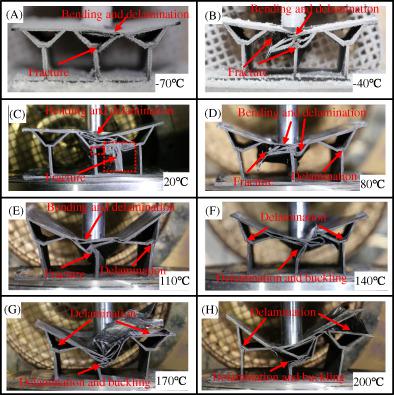当前位置:
X-MOL 学术
›
Polym. Compos.
›
论文详情
Our official English website, www.x-mol.net, welcomes your feedback! (Note: you will need to create a separate account there.)
The indentation responses of composite Y-type cores sandwich structure under various temperatures
Polymer Composites ( IF 4.8 ) Pub Date : 2021-11-11 , DOI: 10.1002/pc.26396 Weimin Jiang 1 , Xiaolan Zhu 2 , Junmeng Zhou 3 , Jiayi Liu 1, 4 , Jingxi Liu 1, 4 , Wei Huang 1
Polymer Composites ( IF 4.8 ) Pub Date : 2021-11-11 , DOI: 10.1002/pc.26396 Weimin Jiang 1 , Xiaolan Zhu 2 , Junmeng Zhou 3 , Jiayi Liu 1, 4 , Jingxi Liu 1, 4 , Wei Huang 1
Affiliation

|
The influences of elevated and cryogenic temperature on the quasi-static indentation responses and damage mechanism for composite Y-type cores sandwich structure were studied by experiments in present paper. The quasi-static indentation experiments were performed to explore the indentation performances for composite Y-type cores sandwich structures under eight different temperature conditions. The influences of the testing environment temperature on the typical indentation force-deformation curves, damage patterns and indentation failure load were investigated and analyzed. The experimental results demonstrated that the testing environment temperature made an important influence on the deformation mechanism, typical force-deformation curves and failure load. Fiber fracture of the front panel was found when the testing environment temperature was below the glass transition temperature, while the fiber microbuckling of the front panel was also revealed when the testing environment temperature was above the glass transition temperature. The failure load increased with the decreasing of the testing environment temperature at cryogenic temperature. Nevertheless, at elevated temperature, the failure load decreased with the increasing of the testing environment temperature attributing to the weakening of the fiber-matrix interface performances.
中文翻译:

复合Y型芯夹层结构在不同温度下的压痕响应
本文通过实验研究了高温和低温对复合Y型芯夹层结构准静态压痕响应和损伤机理的影响。进行准静态压痕实验以探索复合Y型芯夹层结构在八种不同温度条件下的压痕性能。研究分析了试验环境温度对典型压痕力-变形曲线、损伤模式和压痕破坏载荷的影响。实验结果表明,试验环境温度对变形机理、典型力-变形曲线和破坏载荷有重要影响。当测试环境温度低于玻璃化转变温度时,前面板出现纤维断裂,而当测试环境温度高于玻璃化转变温度时,前面板也出现了纤维微屈曲。在低温下,失效载荷随着试验环境温度的降低而增加。然而,在升高的温度下,失效负载随着测试环境温度的升高而降低,这归因于纤维-基体界面性能的减弱。在低温下,失效载荷随着试验环境温度的降低而增加。然而,在升高的温度下,失效负载随着测试环境温度的升高而降低,这归因于纤维-基体界面性能的减弱。在低温下,失效载荷随着试验环境温度的降低而增加。然而,在升高的温度下,失效负载随着测试环境温度的升高而降低,这归因于纤维-基体界面性能的减弱。
更新日期:2022-01-08
中文翻译:

复合Y型芯夹层结构在不同温度下的压痕响应
本文通过实验研究了高温和低温对复合Y型芯夹层结构准静态压痕响应和损伤机理的影响。进行准静态压痕实验以探索复合Y型芯夹层结构在八种不同温度条件下的压痕性能。研究分析了试验环境温度对典型压痕力-变形曲线、损伤模式和压痕破坏载荷的影响。实验结果表明,试验环境温度对变形机理、典型力-变形曲线和破坏载荷有重要影响。当测试环境温度低于玻璃化转变温度时,前面板出现纤维断裂,而当测试环境温度高于玻璃化转变温度时,前面板也出现了纤维微屈曲。在低温下,失效载荷随着试验环境温度的降低而增加。然而,在升高的温度下,失效负载随着测试环境温度的升高而降低,这归因于纤维-基体界面性能的减弱。在低温下,失效载荷随着试验环境温度的降低而增加。然而,在升高的温度下,失效负载随着测试环境温度的升高而降低,这归因于纤维-基体界面性能的减弱。在低温下,失效载荷随着试验环境温度的降低而增加。然而,在升高的温度下,失效负载随着测试环境温度的升高而降低,这归因于纤维-基体界面性能的减弱。







































 京公网安备 11010802027423号
京公网安备 11010802027423号